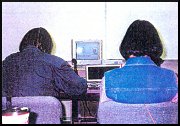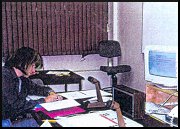

A Literacy Practitioner's Guide to Audiographic Teleconferencing
Due to the scope of the project, I chose not to do the presentations myself. Individuals who were experienced workshop presenters, but had no background experience in audiographic teleconferencing, were recruited to instruct the sessions. This arrangement permitted the project to determine the ease with which they adapted both teaching styles and development of materials to the technology.
It was imperative to acknowledge the literacy coordinators' understanding of their volunteer tutors' training needs and experience levels. They provided input for the first tutor training sessions, LEFT Brain / RIGHT Brain, during a practice session for the literacy coordinators and the instructor. The literacy coordinators were asked to evaluate the module content, including the audiographic teleconferencing presentation, study guide and User's Handbook.
The practice session for LEFT Brain / RIGHT Brain allowed Ms. Shillington to become better acquainted with the technology and make adjustments to her delivery. It also permitted Rod Corbett to evaluate the technical aspects of the presentation and the User's Handbook and make recommendations for improvement.
The volunteer tutors were asked to fill out a needs assessment following their first training sessions to determine their learning needs for the second module to be presented by Robin Millar. By taking into account prior learning, tutor interests and current tutoring experience, Ms. Millar was able to design her sessions to meet the needs of participants. She combined learning styles and strategies, learning disabilities and meta cognition into a comprehensive training package.

